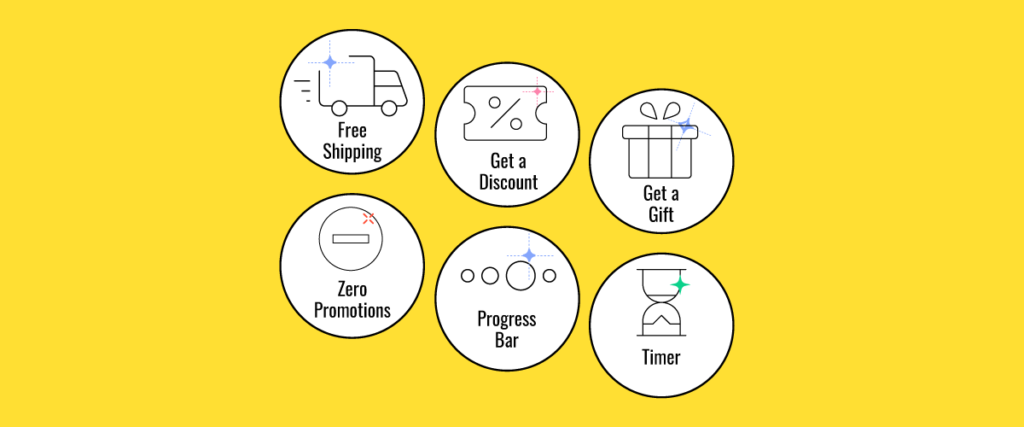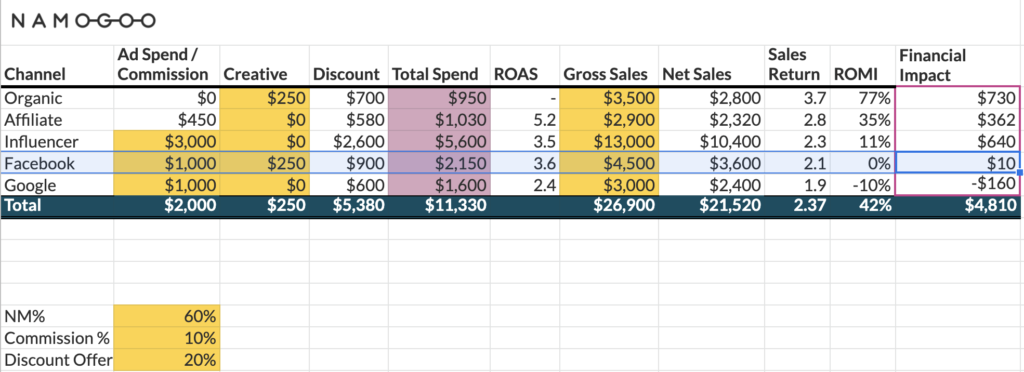Free training: How to Convert First-Time Visitors into Loyal Customers
Below, we’ll go over 9 examples of behavioral segmentation at play at every stage of the customer journey. We’ll:
- Start with how to use customer segmentation strategy to identify, target, and attract your target customers to your eCommerce site.
- Go over some examples of behavioral segmentation to optimize their customer experience and lead them through the consideration stage.
- Review examples to shed light on behavioral segmentation strategies that improve conversion funnel metrics, including conversion rate, average order value, revenue per visitor and abandoned carts.
Finally, you’ll learn some strategies to surprise, delight and retain customers, turning first-time customers into repeat buyers and loyal brand advocates.
Example #1: Identify & Reach Your Target Customers Profitably
Channel: Paid Social, Retargeting
Behavioral Segmentation Type: Customer Engagement, Buying Behavior, Timing
Metrics: Return on Ad Spend, Conversion Rate, Discounting Rate, CAC
One of the most common ways that top online retailers use behavioral segmentation is in advertising.
Platforms like Facebook and Google use AI and machine learning to collect, analyze and manipulate billions of data points to target segments of customers with incredible precision.
Check out this behavioral segmentation example to see how specific your targeting can get.
A B2B MarTech company in the eCommerce SaaS industry might find that men between the ages of 25-44 account for the majority of conversions:
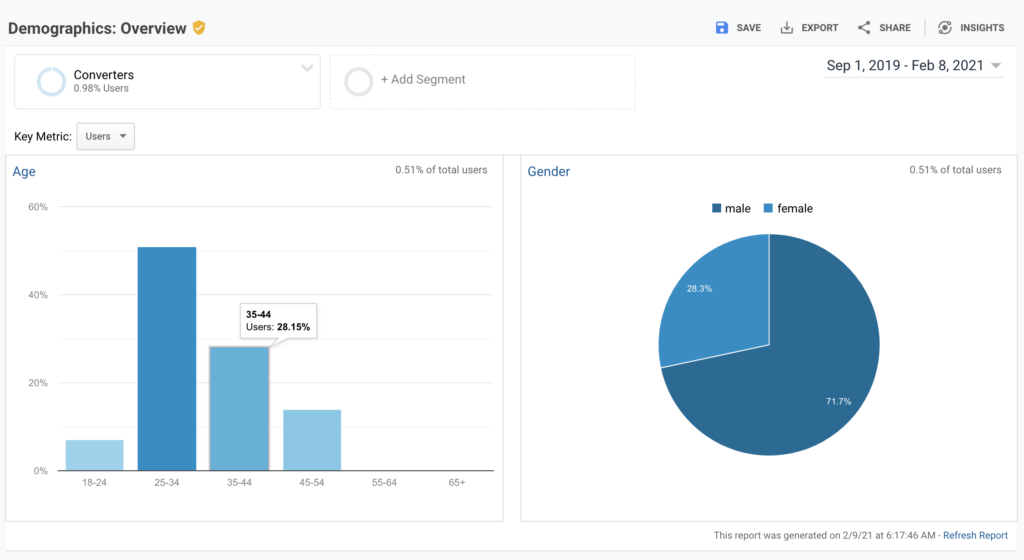
Let’s say they’re specifically concentrated in the US, Canada and the UK.
If this brand were to target based only on demographic segmentation, this makes for a very broad audience:

60 million people is too broad to be effective.
If this company was an eCommerce app, it could identify the psychographics of the target audience by:
- Adding interests such as Shopify, BigCommerce, and other eCommerce platforms:

- Targeting those interested in online business topics:
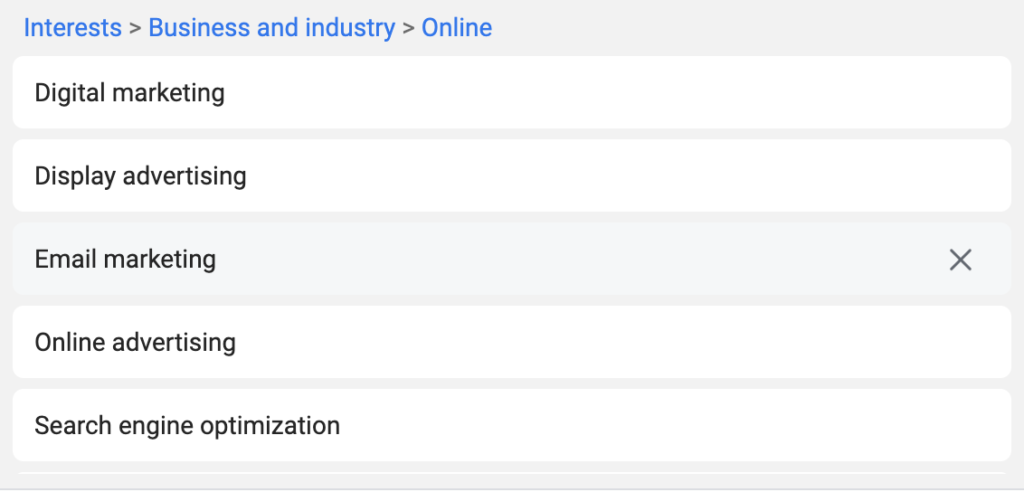
- And even add other enterprise-level applications and softwares to the mix, like HubSpot or SalesForce, to qualify the prospects.
When we add psychographic segmentation to the mix, we find that the audience is still broad, but at 12 million, it’s substantially more targeted than the 60 million demographic-only audience.
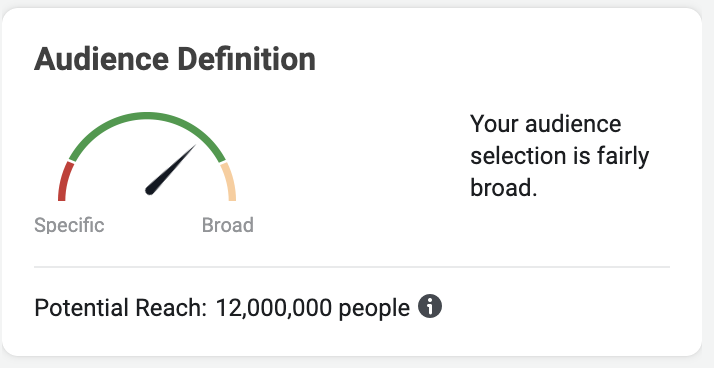
We can get far more precise with behavioral segmentation. For example, I can choose people who are admins of Facebook business pages or retail pages:
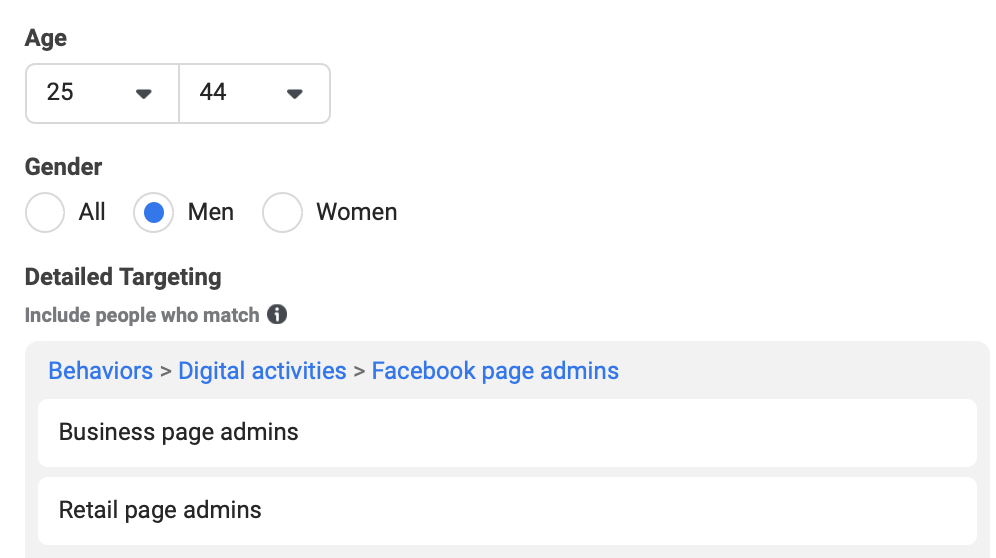
And now I’ve narrowed the audience to 1.2 million people who are far more likely to fit this example brand’s target audience than the entire population that matches based on demographics and psychographics.
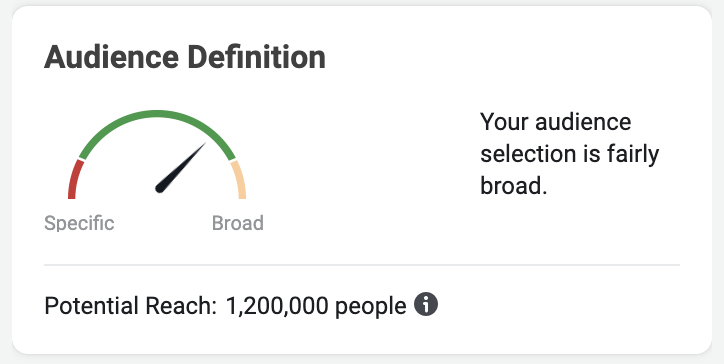
Of course, you can and should take it further, to refine your messaging (see below) and drive CAC down.
For example, a speciality products retailer like Uncommon Goods could use behavioral segmentation to build audiences of people who are celebrating their anniversaries within 61-90 days, delivering ads for anniversary gifts.
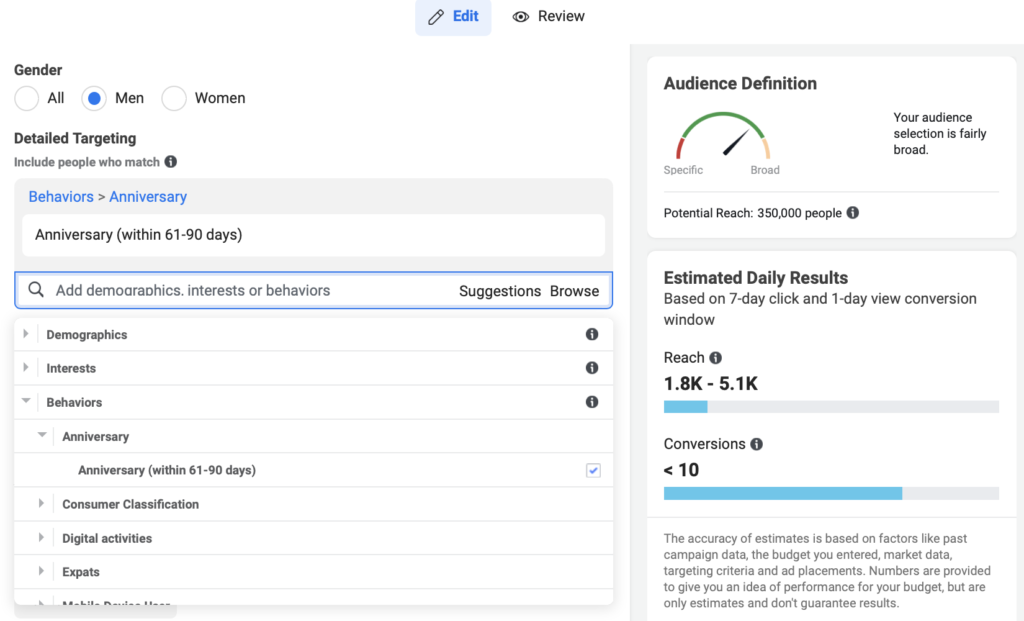
Behavioral segmentation provides a powerful opportunity in digital advertising to drive ROAS and CAC.
Example #2: Step Up Prospecting with One-to-One Copy
Channel: Paid Social Media
Behavioral Segmentation Type: Customer Engagement, Customer Journey Stage
Metrics: Clickthrough Rate, Return on Ad Spend
Demographics and psychographics can help you to increase customer acquisition by serving ads to the people who are most likely to fit within your buyer personas.
But that’s not enough in today’s eCommerce landscape. Your competitors are also using demographics and psychographics to get in front of the same users.
For example, I was recently shopping for jeans. Within a couple of days, I was served ad campaigns from 3 different denim brands, like this:
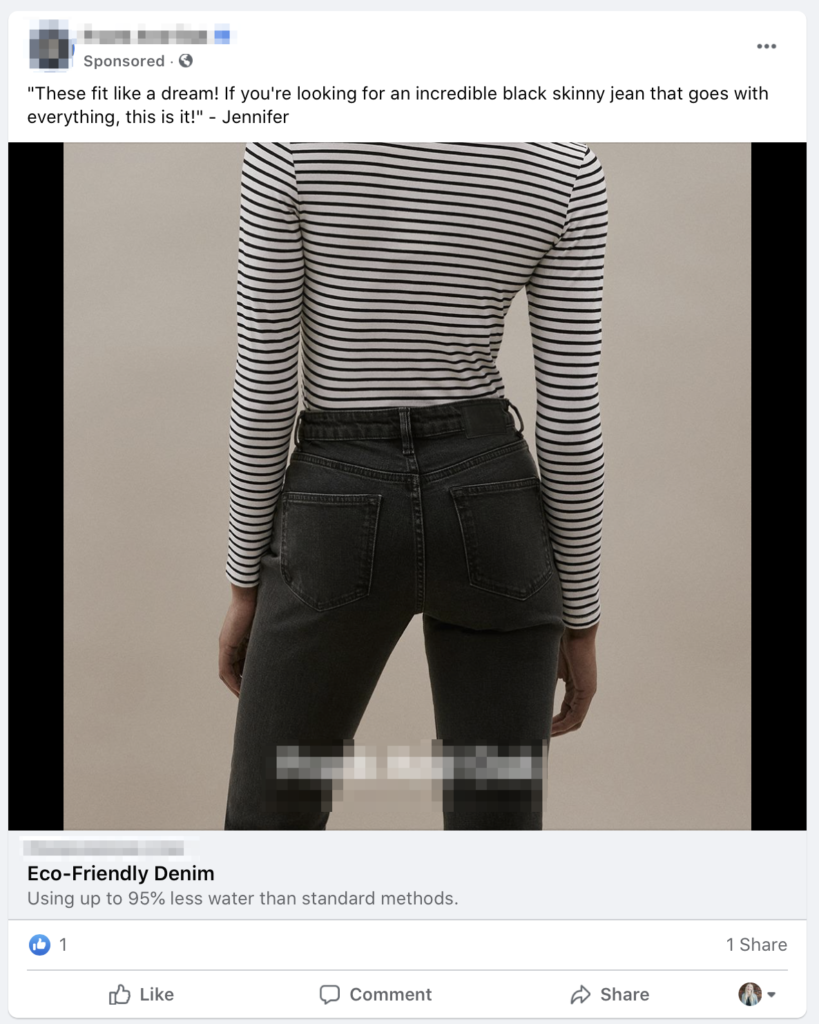
All three were eye-catching. But there was only one that took their segmentation to new heights and cut through the clutter of my newsfeed:
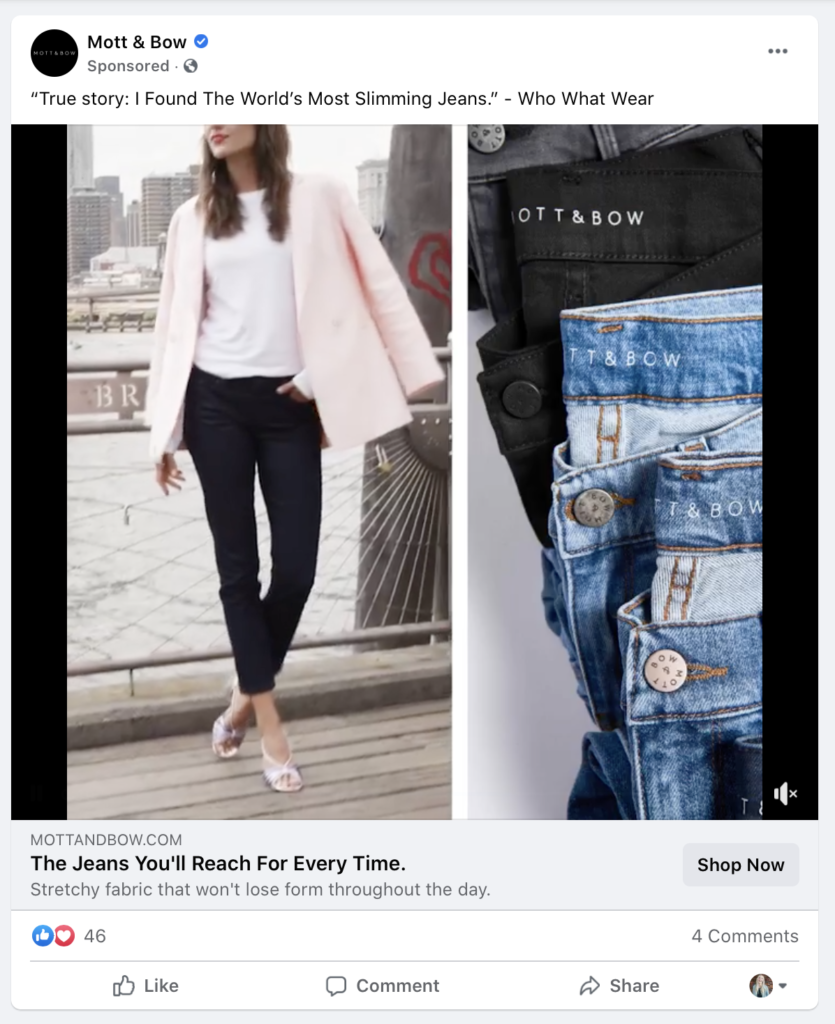
The difference between the first ad and this one?
I had been doing some research for this article and had searched for and landed on a couple of eCommerce stores that offered weight loss products. Mott & Bow used that data to refine their marketing messaging to deliver personalized messaging:
“True story: I Found The World’s Most Slimming Jeans”
The more generic messaging of the other brands didn’t stand a chance.
To stand out, you need to make the potential customer feel like your products are the best fit for their specific needs.
Enter: behavioral segmentation.
Behavioral targeting enables you to get more specific in your marketing messaging and make your target customers feel as if you’ve read their minds or created your products just for them, cutting through the noise and rising above the competition.
Once you’ve attracted your target customers with specific, targeted marketing messaging, you need to ensure they stick with you throughout their customer journey.
Example #3: Drive ROI & Build a Sustainable Sales Promotion Strategy for More Onsite Conversions
Channel: Onsite, Omni-channel
Behavioral Segmentation Type: All
Metrics: Conversion Rate, Average Order Value, Revenue Per Visitor, Discounting Rate
A well-constructed sales promotion strategy can:
- Drive conversions
- Boost average order value
- Improve customer retention and lifetime value
- Preserve brand equity
- Protect margins and profitability
Optimize ROI for every digital marketing channel.
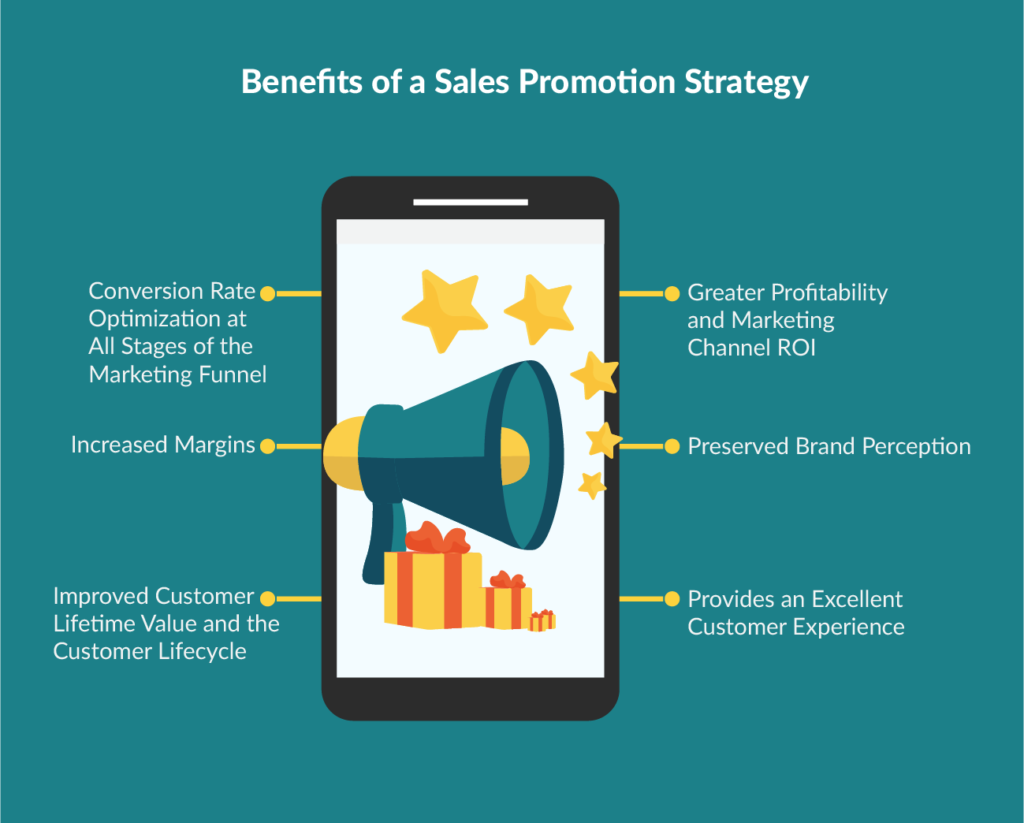
And in 2021, your sales promotion strategy is only as strong as your behavioral segmentation game.
Using AI-driven predictive analytics and behavioral data, you can ensure that your customers from each channel are getting the precise sales incentive that is most likely to drive them to convert, without sacrificing channel profitability.
For example, perhaps I know that users coming from Facebook ads are less likely to convert on their first session than those from Google.
I can display a discount offer to them to improve my first-session conversion rates.
I might find that I can offer a discount of up to 20% to users coming from Facebook while still breaking even, based on my net margin, ROAS, and creative spend.
>> Get access to this worksheet
Of course, I don’t want to offer 20% to everybody. Breaking even doesn’t exactly promote long-term, sustainable revenue growth.
So instead, I let behavioral segmentation work it’s magic to drive down the discounting rate.
Using behavioral data from analyzing over two billion eCommerce store sessions every single week, Intent-Based Promotions can determine exactly what discount the user is most likely to need to be offered to convert, and serve it to them.
So I set the discount range as between 0-20%.
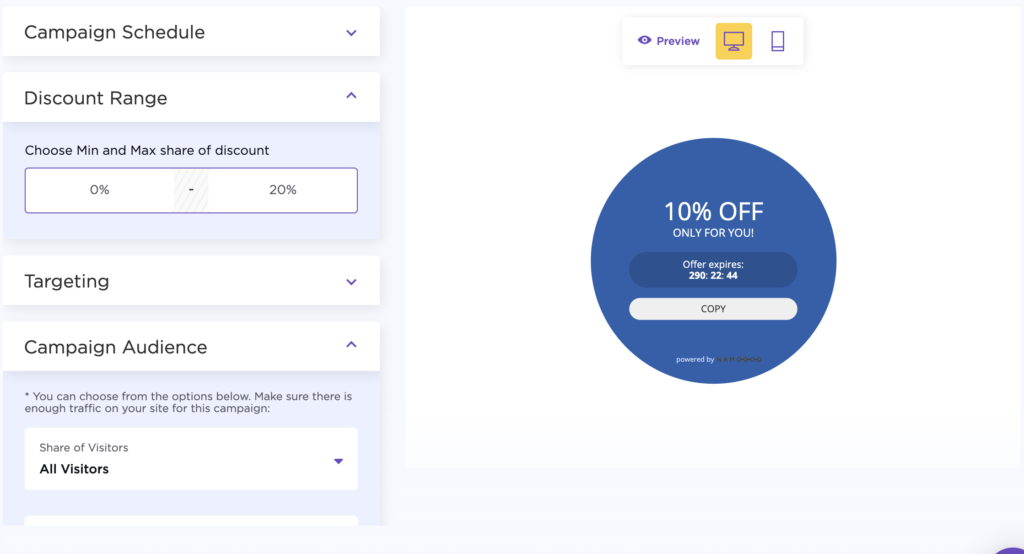
Identify the channels through which this discount can be offered:
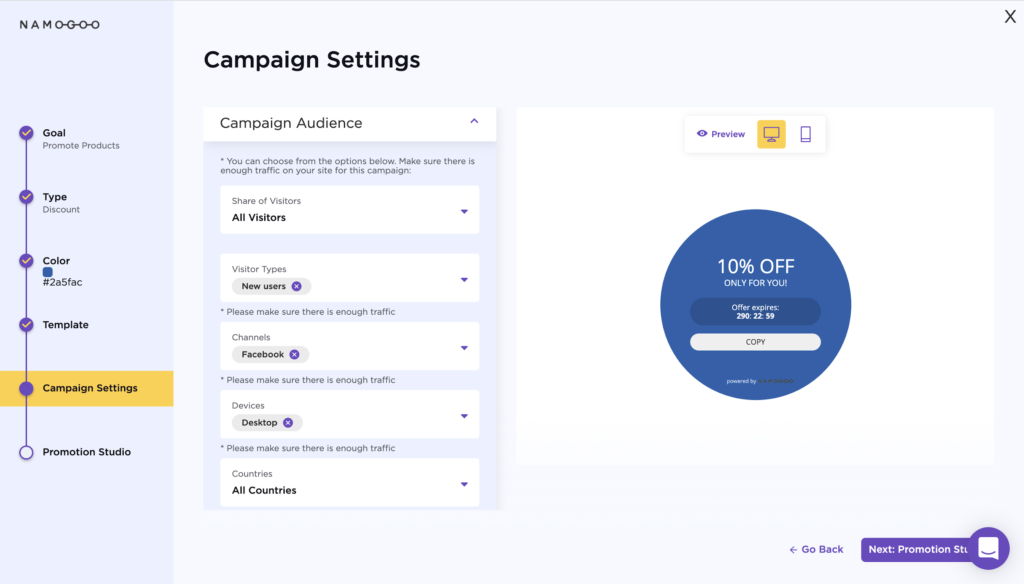
And let the data do the work.
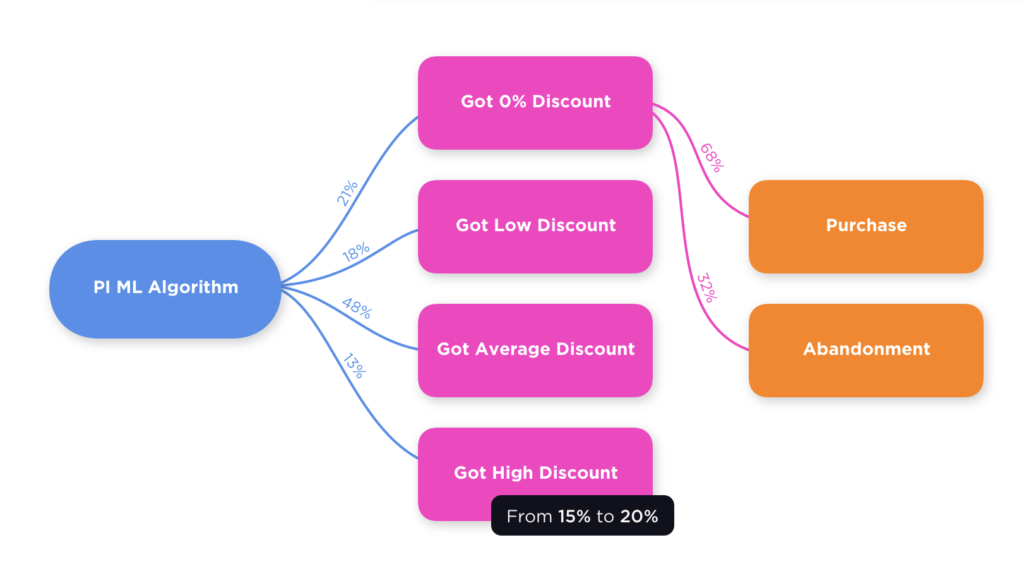
Now I know that the 20% discount will only be offered sparingly to those who need it to complete the sale. Everyone else will get the offer that most likely to be effective for them, based on their intent.
Example #4: Increase Social Proof Through Positive Reviews
Channel: Email
Behavioral Segmentation Type: Customer Brand Loyalty
Metrics: Reviews, Conversion Rate
Online, social proof matters.
93% of online shoppers identify product and brand reviews as an important buying consideration[*].
Online reviews are also a known ranking factor for search, and the more positive, 5-star reviews a product page has, the higher the conversion rate.
But it’s not enough to send a generic call to action to all of your customers to leave a review. Quality of reviews count, especially for the customer segments that engage in complex or dissonance-reducing buying behavior.
After all, which are you more likely to buy? This pair:
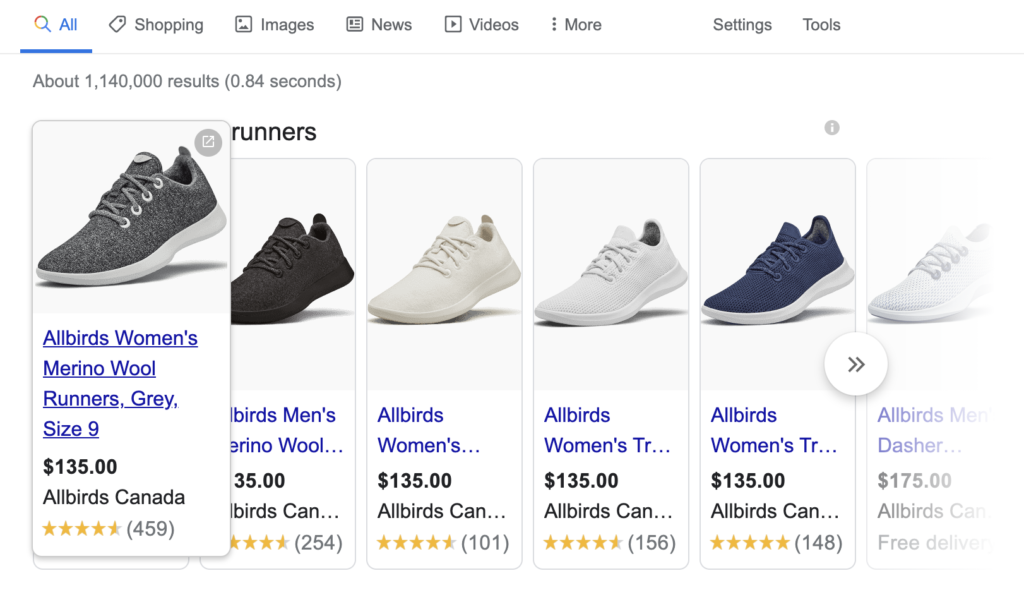
Consumers look at both number and star rating, and weigh their purchasing decisions based on a mix of both.
Even if you loved the look of the trainers in the second screenshot, the extra star and hundreds more reviews makes a huge difference.
So you need both a lot of reviews, and they need to be overwhelmingly positive.
And you can curate your reviews through behavioral segmentation.
Identify those who have purchased from you, and create behavioral customer segments based on Customer Brand Loyalty to send the review call to action only to those who are clearly happy customers, such as:
- Repeat buyers
- Subscribe-and-save customers
- Customers who are part of a loyalty program
- Customers who’ve sent referrals.
By focusing on the loyal customer segments, you’re reducing the likelihood of an unhappy customer leaving a negative review before you’re able to make things right with them.
Those segments of customers? You can reach out and treat differently, winning them back or collecting feedback.
Example #5: Optimize Your Conversion Funnel with a Personalized Customer Experience
Channel: Onsite
Behavioral Segmentation Type: Onsite Behavior, Purchase Intention, User Status
Metrics: Abandoned Cart, Conversion Rate
In 2019, brands that invested in personalization reported a 20x return for every dollar spent[*].
This makes sense.
After all, some segments of your target market are sensitive to sales promotions and purchase incentives, but some aren’t. Some potential customers have high intent to purchase, and don’t need a promotion to convert.
By presenting those shoppers with a generic promotion, you’re not only leaving revenue on the table, but also potentially hurting brand perception by communicating that you’re a discount brand.
Drilling down further, there are segments of customers who respond more favorably to free shipping than a percentage discount. Some will only buy on sale, while others will only buy at specific times of the year.
You can use behavioral segmentation to identify those in each group and personalize the customer experience through the promotions and offers they see onsite.
So as a repeat customer, I might see a call to action to join a rewards program:
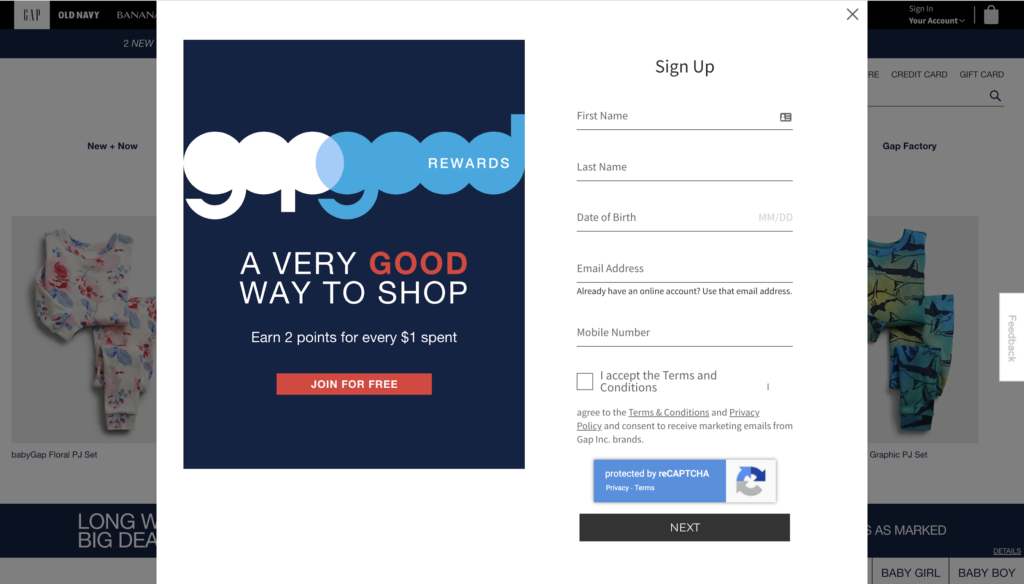
Whereas a first-time visitor might see a 25% off discount for the first order.
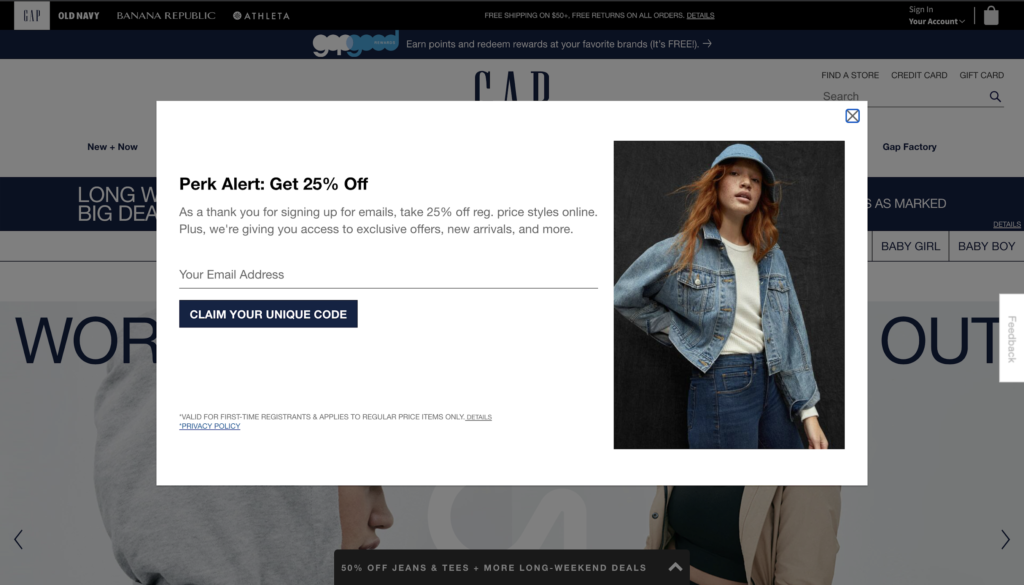
Your team could attempt to replicate this example manually, but advanced eCommerce AI tools segment your customers automatically based on behavioral data, and serve a one-to-one customer onsite experience that is personalized to them.
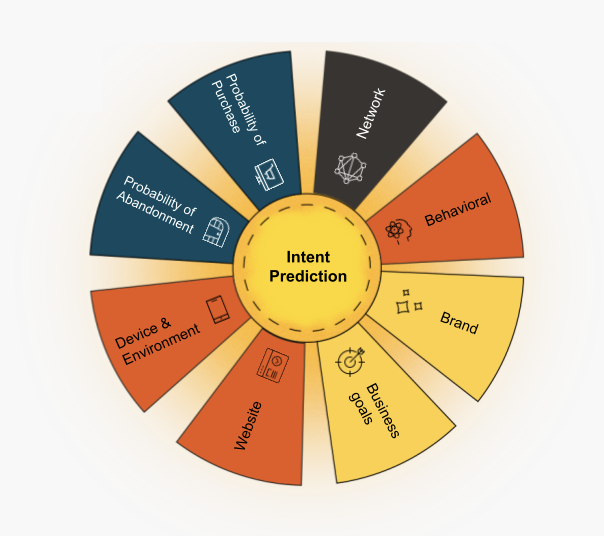
In the example presented above you can see how Intent-Based Promotions calculates shoppers’ purchaing patterns and intent to determine the right offer for each specific customer during their session, based on behavioral data such as:
- User status
- Acquisition channel
- Purchase intent
- Onsite behavior
- Spending habits
- Customer journey stage
Using behavioral data enables a personalized customer onsite experience that leads to improved conversion rates, increased average order value, reduced cart abandonment, and protected brand perception.
Want proof?
This customer was able to personalize the promotions offered to each website visitor according to their purchase propensity specific for each session with Intent-Based Promotions:
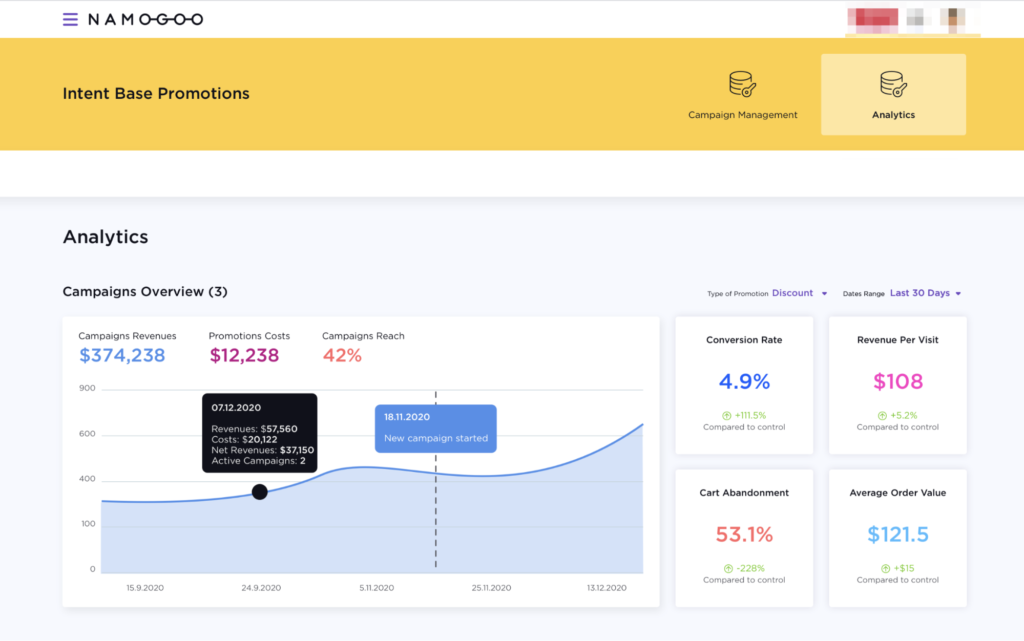
With this one promotion campaign alone, this eCommerce retailer saw:
- 111% increase in conversion rate
- 2% increase in revenue per visitor
- 228% reduction in cart abandonment
- $15 increase in average order value.
Example #6: Reduce Shopping Cart Abandonment
Channel: Onsite
Behavioral Segmentation Type: Onsite Behavior, Purchase Intention
Metrics: Abandoned Cart, Conversion Rate
69% of shoppers abandon their shopping carts.
eCommerce teams know that this is a huge problem. These are users who have gotten to the very bottom of the marketing funnel, and are about to convert, but then something stops them.
And the device from which they’re browsing influences their likelihood of abandonment.
Data collected from the sessions of 250 top online retailers shows that 74% of customers shopping from their mobile devices abandon their carts compared to 61% of desktop users.
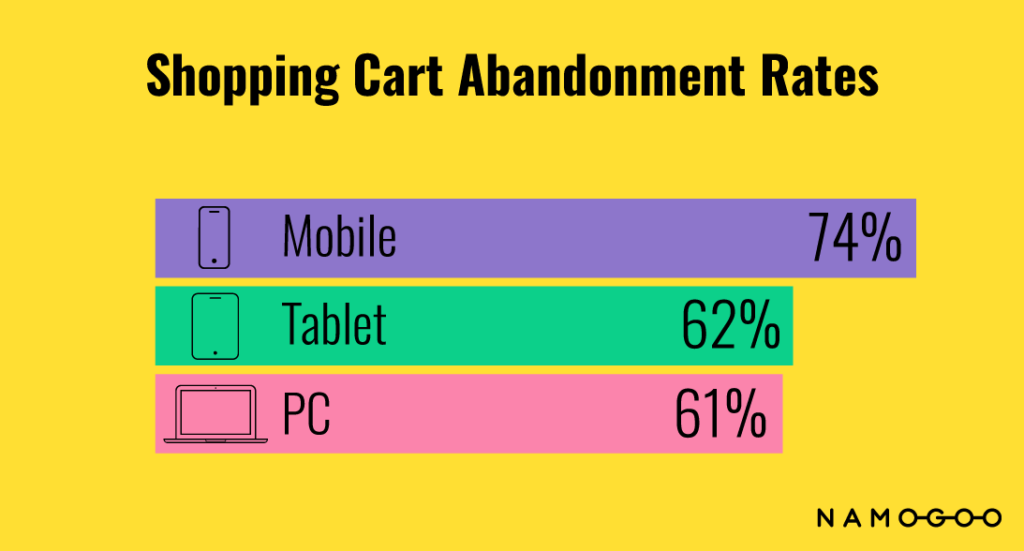
This suggests that those browsing on their phones have a lower intent to purchase than those on their tablets or desktop, allowing you to create a powerful behavioral segment based on purchase intent.
You can identify users who are about to abandon their carts and:
- Deliver an incentive to keep those most likely to purchase (desktop users) on the page before they bounce.
- Engage those who are browsing from their mobile device in a different way, and retarget or remarket to them later when they’re on their desktop.
To reduce cart abandonment for desktop users, deliver an incentive to purchase via an exit intent pop-up on the cart page.
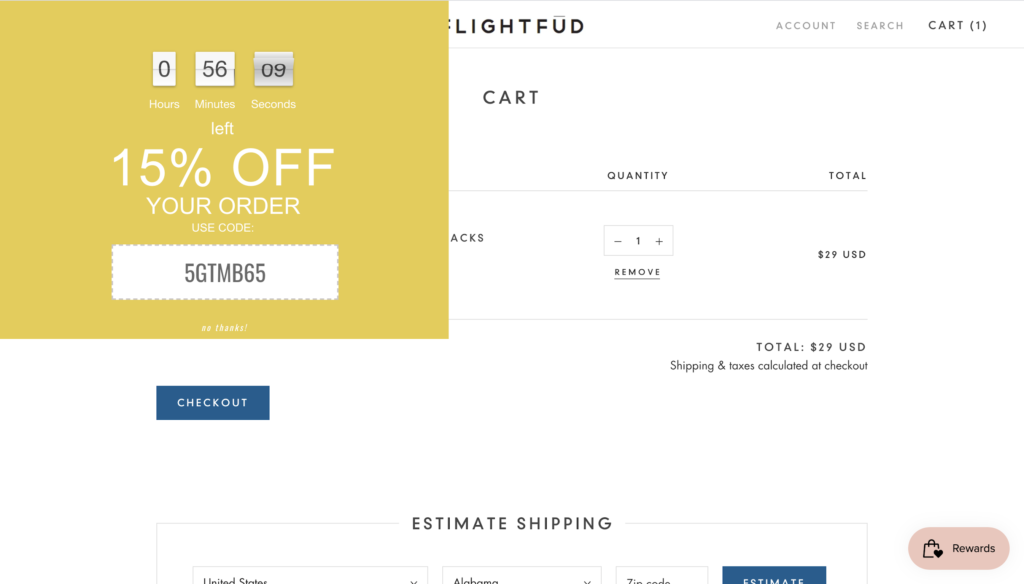
When I’ve done this for a client previously, we were able to convert nearly 1400 customers who were about to abandon their carts:

And that was with a generic, one-size-fits-all coupon code.
You can take this strategy to the next level by offering ultra personalized promotions based on real-time intent, that is most likely to entice each customer to convert.
When you set up a new Campaign, choose Decrease Cart Abandonment. Choose the discount range that fits with your sales promotion strategy.
Protip: Use the profitability calculator to ensure an ROI on each channel.
Example #7: Recover More Carts with Laddered Offers
Channel: Email, Social Media Advertising
Behavioral Segmentation Type:
Metrics: Abandoned Cart, Conversion Rate
Your first line of defense against losing customers at the cart stage is reducing digital shopping cart abandonment before users bounce.
But no matter how effective your abandoned cart pop-up offers are, some of those potential customers will bounce. And behavioral segmentation can help you make sure they’re not lost forever.
Use behavioral analytics to send remarketing campaigns with laddered sales discounts.
When we did this with one of my previous clients, we were able to recover abandoned carts while upholding brand perception and reducing discounting rate, by starting with a simple reminder about the abandoned cart, with no discount:
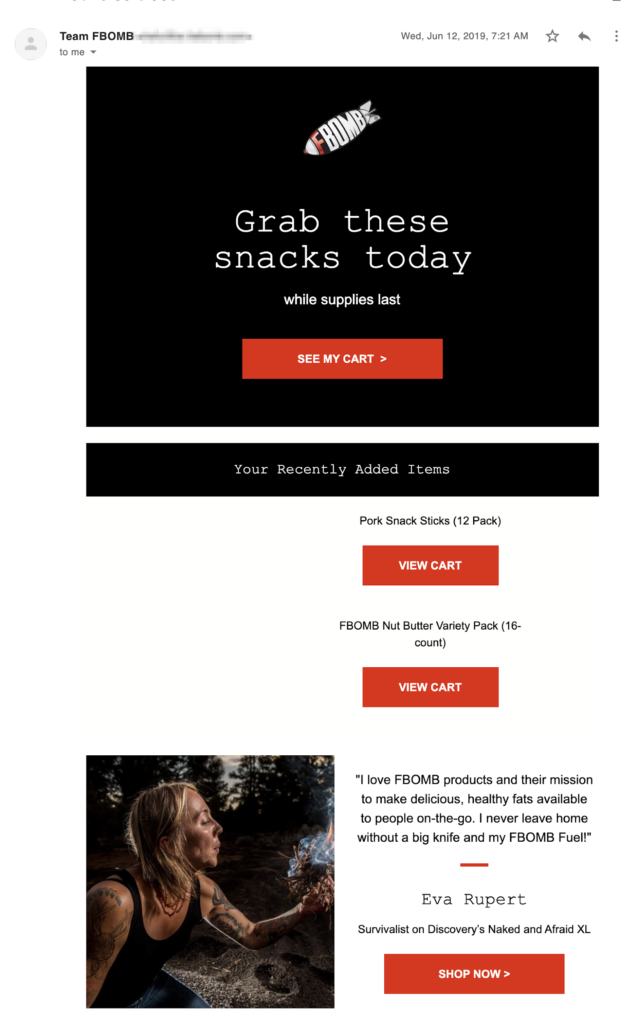
When a customer makes a purchase from one of the remarketing emails, they are automatically removed from the abandoned cart email series, and won’t get the rest of the emails in the flow.
Pair this strategy with the previous example to ensure promotion continuity onsite, and you’ll truly drive your abandoned cart rate down.
Example #8: Increase Cart Size with Recommended Products
Channel: Email
Behavioral Segmentation Type: Onsite Behavior, Brand Engagement, Product Engagement
Metrics: Average Order Value, Revenue Per Visitor, Customer LTV
Increasing cart size doesn’t just increase revenue and RPV.
It can also come along with a rise in customer lifetime value as you:
- Introduce customers to high-retention products
- Improve your margins (as it can be expensive to ship just one item)
- Ensure customer journey continuity.
And you can use behavioral segmentation to increase cart size and average order value by providing personalized product recommendations.
For example, one of Namogoo’s customers, Carhartt, used behavioral segmentation based on my onsite behavior to analyze my cart contents and the products I’d viewed, and recommend other products I may be interested in.
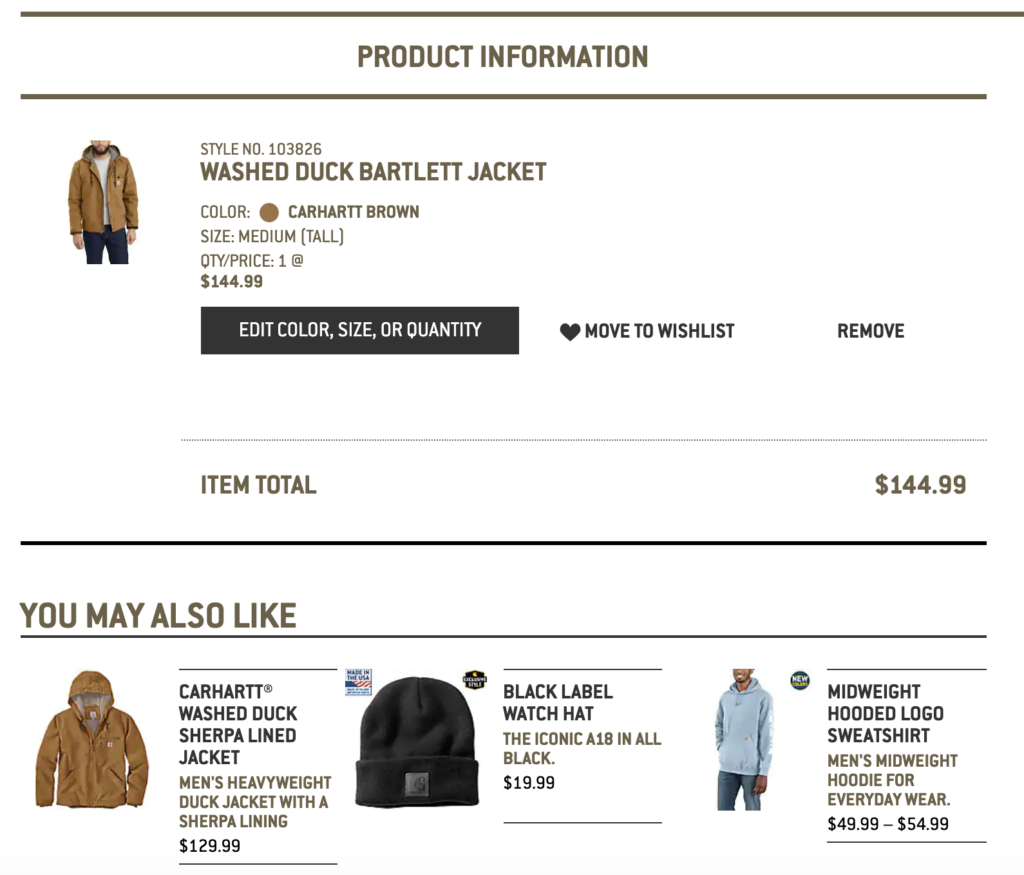
Whereas demographic data would have recommended women’s clothing based on my gender, behavioral data allowed Carhartt to determine I was shopping for men’s clothing (so likely buying a gift).
Using behavioral analytics, your customers can get personalized product recommendations most relevant to them.
Example #9: Increase Monthly Recurring Revenue
Channel: Email, Paid Social Media
Behavioral Segmentation Type: Customer Brand Loyalty
Metrics: Monthly Recurring Revenue, CLTV
A solid eCommerce subscription program can:
- Increase customer lifetime value
- Improve customer engagement
- Support scalable eCommerce revenue growth.
Enabling online retailers to reap the rewards that come with monthly recurring revenue (MRR), it’s no wonder that product subscription programs are the holy grail of eCommerce.
And you can use behavioral segmentation to increase MRR by identifying repeat customers, and promote your subscription program to the customers most likely to join it.
Check out the example below.
I’m a repeat customer of Four Sigmatic with habitual buying behavior of their products. I don’t shop around for other mushroom coffee products, and used to buy the product regularly. I was a medium to heavy user of the product.
Four Signmatic identified these customer behaviors and promoted their membership program.

And via a Facebook ad.
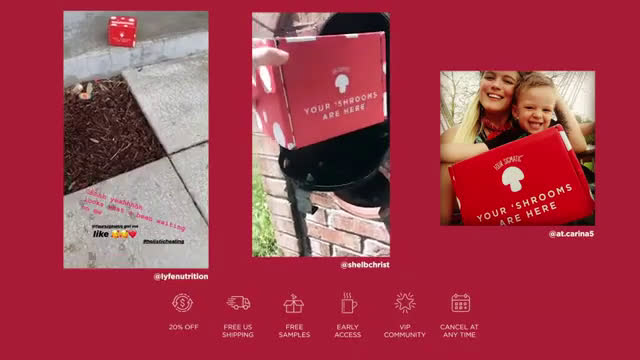
Lifetime value for subscription customers is higher than for those one-off purchasers, and behavioral segmentation can help you drive subscription growth.
Bonus Example: Block Competitors from Hijacking Your Customers
Channel: Onsite
Behavioral Segmentation Type: Brand Engagement
Metrics: Revenue, Shopping Cart Abandonment, Conversion Rate
Average eCommerce conversion rates are 2.4%.
That means that 97.6% of website visitors don’t convert.
To put a more positive spin on it, you have a huge opportunity to entice nearly 98% of your visitors back to your website to convert…
If your competitors don’t get to them first and hijack the customer journey from you.
If this sounds far-fetched, it’s not:
20% of your website’s visitors are being served unauthorized product ads, pop-ups, and banners via injected ads that divert them to competitor sites.
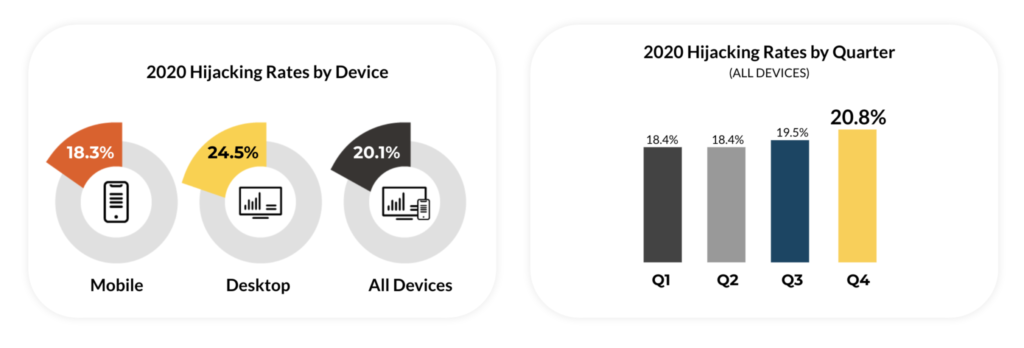
This is what we call customer journey hijacking, and it poses a huge threat to revenue, brand equity and eCommerce KPIs.
One of our customers, GlassesUSA.com has recovered $3.7 million by preventing customer journey hijacking.
This is possible through Namogoo’s Customer Hijacking Prevention solution.
This is a bonus example because it does double duty by:
1. Blocking your competitors from using behavioral data from your customers to retarget them with injected advertisements.
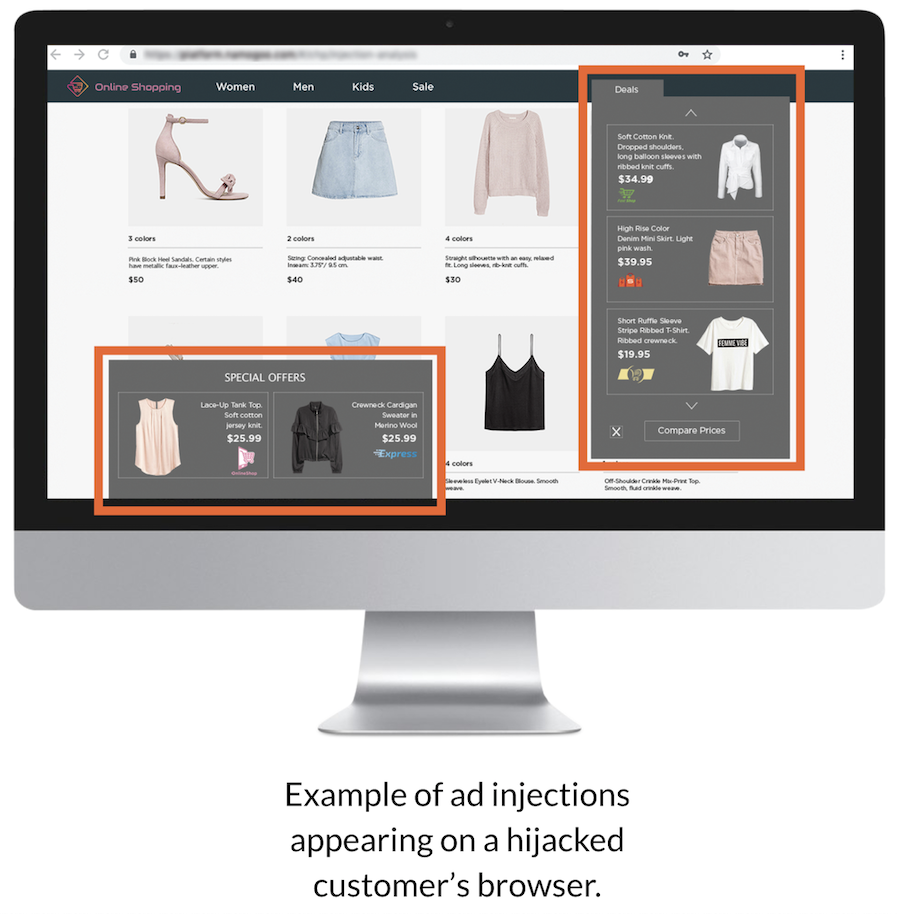
2. Allowing you to protect and recover the customer journey, using that same data to engage in behavioral segmentation, and increase conversion rates…
a. Across all devices:
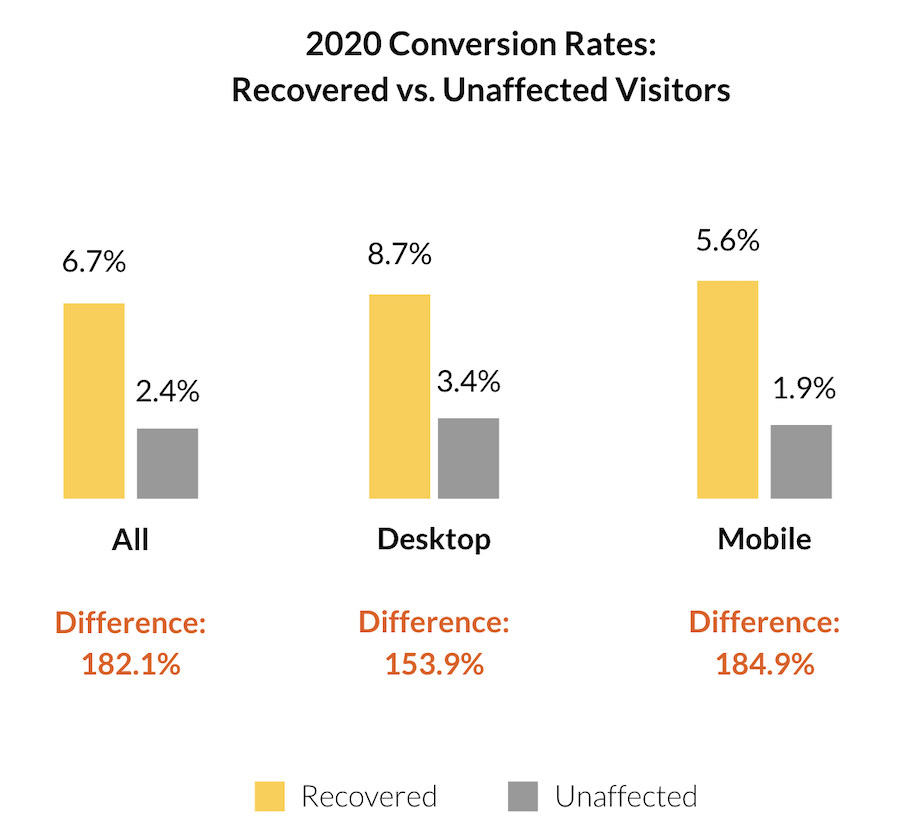
b. And across all industries:
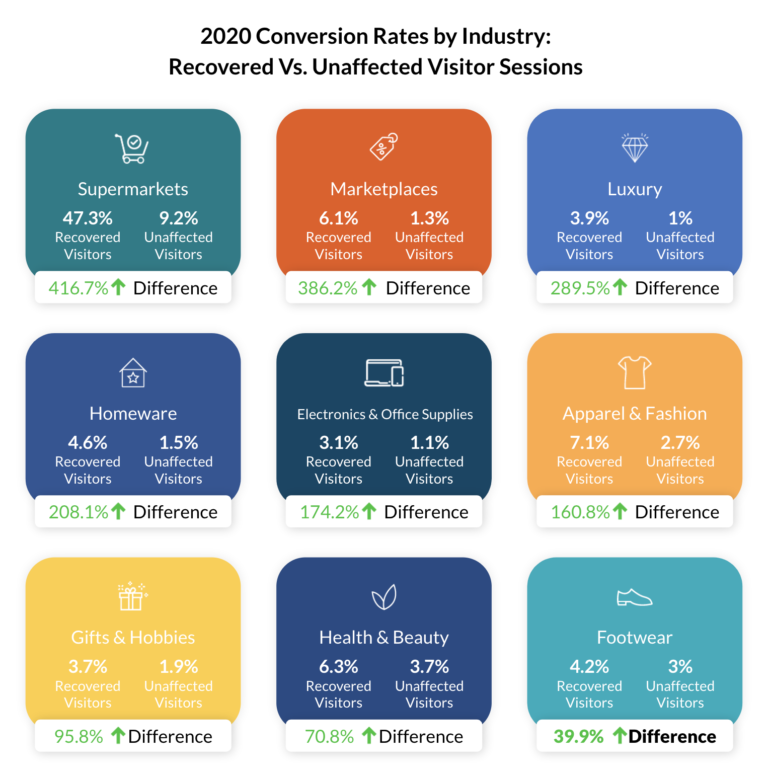
In 2020, brands that used Customer Hijacking Prevention increased their eCommerce revenue by $1.62 billion, and protected brand perception in the process.
>> Book a demo – discover how Customer Journey Hijacking is affecting your eCommerce customers and site’s KPIs
Optimize the Customer Journey with Behavioral Data
You just saw 9 behavioral segmentation examples that demonstrate how to use this advanced technique to improve your eCommerce marketing strategy.
We’ve given you examples to strengthen virtually every stage of the customer journey. You have the type of behavioral segmentation that each technique employs, the funnel metrics and KPIs that are impacted by each.
We’ve even shown you how your team can implement many of these examples to reap the rewards of behavioral segmentation… often without having to do the heavy lifting of actually segmenting your customers based on their individual behaviors.
All that’s left to do is build these examples into your strategy.



